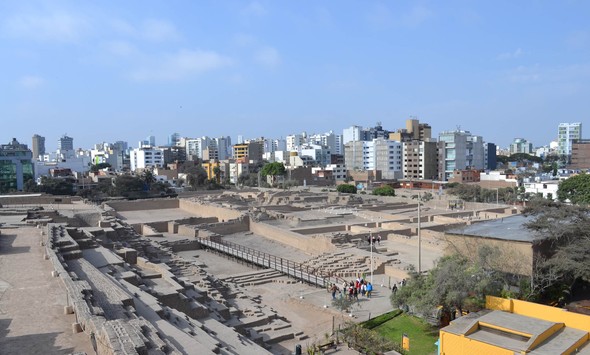Jed Koball, Companionship Facilitator, Red Uniendos Manos, JH Peru

In the heart of the rapidly growing city of Lima, 1500 year old ruins stand their ground in the face of modern development. Photo courtesy of Jed Koball.
Over the past ten years, the Peruvian economy (as measured by its GDP) has grown by an average of 6.4% a year. When the global financial crisis hit in 2008, Peru was largely untouched. In fact, according to certain government indicators, poverty has been reduced from approximately 54% to about 25% in that timeframe, while the middle class has experienced never before seen growth, especially in the capital city of Lima. Today, despite a projected slow down in the economy (to approximately 5% growth in 2013) due to falling metal prices, Peru continues to have one of the fastest growing economies in Latin America. But, at what cost?
To begin to answer this question, it is important to look at the economic growth strategy employed by successive governments since the early 2000´s, namely, economic development spurred by foreign investment principally within the extractive industry. A series of policy decisions, related not just to taxes and trade barriers but also environmental regulations, labor rights, and indigenous rights, has made Peru increasingly attractive for investment opportunities by multinational corporations. Mining companies from the U.S., Canada, China and beyond continue to line up to negotiate billion dollar projects throughout the Andes mountains. Peru is a world leader in the production of gold, silver, copper and more. At the national level, the political debate between the left and right is not whether this is an effective economic growth strategy, rather how the profits should be distributed.
At the local level outside of Lima, a different story is developing. In this same timeframe of tremendous economic growth, there has also been a rise in social conflicts – both in number and intensity. In the very areas where mining is ongoing and new projects are being developed and new deals being negotiated, the people are taking a stand as their voice is evermore silenced by the national government. Environmental regulations that protect their waters, soils, air and ultimately their health and livelihoods are being “re-interpreted” if not outright ignored. Indigenous rights to determine the use of their land are likewise circumvented. A recently passed law that preserves the rights of indigenous peoples to have authority in accepting or denying mining projects within their territory is being poorly implemented and enforced. And most recently, a law that was passed in 2009 and that was to be implemented and enforced as of 2014 to significantly reduce acceptable levels of sulfur-dioxide emissions into the air was ¨re-interpreted¨ by the Ministry of Environment. This “re-interpretation” allowed industries operating with the highest levels of emissions to postpone the implementation of the new regulations.
As many Peruvians will contest, ¨we have good laws; they just aren´t enforced.¨ A recent study done by an independent organization, ISOP, illustrated that over the past ten years, during the time of this economic boom, the perception of the population has dramatically shifted with regard to what it views are the most critical problems facing the country today. In 2002, the vast majority identified unemployment and poverty as the two greatest issues facing Peru. As of 2012, the majority now identifies corruption as the single greatest issue facing Peru today.
Paz y Esperanza, a member organization of the Red Uniendo Manos Peru, has launched a campaign with the support of the National Council of Evangelicals in Peru to fight corruption. This campaign is a contextualized effort of a larger global campaign called ¨Exposed¨, calling upon evangelicals around the globe to organize, stand up, and ¨shine a light on¨ corruption in all forms. As an ecumenical organization, the Red Uniendo Manos Peru joins with Paz y Esperanza and evangelicals across Peru to address the many manifestations of corruption. Indeed, in this effort, the Red brings critical questions to the table as we identify the roots of corruption and the frameworks that sustain it.
To this end, the Red returns to the very issue of the cost of economic growth of Peru over the past decade and the strategic efforts of successive governments to make Peru attractive to foreign investment. In this realm it is difficult to argue that corruption is merely a matter of a few bad apples operating in an otherwise healthy system and structure. If we are serious about addressing corruption and the social conflicts that result, we must begin to address the very framework that allows and even promotes corruption. We must question the very validity of the democratic processes defined not only by the Constitution of Peru, but the supposed democratic processes that tie nations together through trade agreements.
In this effort, the Red continues to be actively involved in addressing the ongoing negotiations of the Trans Pacific Partnership – a multinational trade agreement that threatens to undermine the sovereignty of the State. Negotiated behind closed doors and with the consultation of select industry leaders, the voice of the people and the public policies and regulations that protect them are at great risk. The avenues to a government of, by and for the people have been corrupted. What greater cost could there be for such economic growth? We, the Church, must indeed ¨shine a light¨ on this travesty.
![]() You may freely reuse and distribute this article in its entirety for non-commercial purposes in any medium. Please include author attribution, photography credits, and a link to the original article. This work is licensed under a Creative Commons Attribution-NonCommercial-NoDeratives 4.0 International License.
You may freely reuse and distribute this article in its entirety for non-commercial purposes in any medium. Please include author attribution, photography credits, and a link to the original article. This work is licensed under a Creative Commons Attribution-NonCommercial-NoDeratives 4.0 International License.